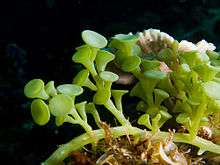Caulerpa racemosa
| Caulerpa racemosa | |
|---|---|
 | |
| Scientific classification | |
| Kingdom: | Plantae |
| Division: | Chlorophyta |
| Class: | Bryopsidophyceae |
| Order: | Bryopsidales |
| Family: | Caulerpaceae |
| Genus: | Caulerpa |
| Species: | C. racemosa |
| Binomial name | |
| Caulerpa racemosa (Forsskål) J.Agardh, 1873 [1] | |
| Synonyms | |
| |
Caulerpa racemosa is a species of green alga, a seaweed in the family Caulerpaceae. It is commonly known as sea grapes and is found in many areas of shallow sea around the world. There are a number of different forms and varieties, and one that appeared in the Mediterranean Sea in 1990 is giving cause for concern as an invasive species.
Taxonomy
There are about 75 species of Caulerpa. Many of them exhibit polymorphism, showing different growth forms in different habitats which makes them difficult to identify. Caulerpa racemosa, C. laetevirens and C. peltata form a species complex. A number of forms and varieties for C. racemosa are listed but further study is needed to clarify their exact phylogenetic relationships.[2][1]
Description
A plant of C. racemosa consists of a number of branches linked to stolons which are anchored to the sandy substrate by rhizoids. The branches are a few centimetres apart and can grow to a height of 30 centimetres (12 in). Many spherical or ovate side-shoots branch off these and give the seaweed its name of sea grapes.[3] Like other members of the order Bryopsidales, each C. racemosa plant consists of a single enormous cell with a large number of nuclei. The chloroplasts containing chlorophyll are free to migrate from any part of the organism to another and there is a network of fibrous proteins that helps movement of organelles.[4]
Distribution

C. racemosa is widely distributed in shallow temperate and tropical seas. In 1926 a new form of the alga was reported off Tunisia, possibly an immigrant from the Red Sea, and this later spread to much of the eastern Mediterranean Sea. In 1990, a new, larger form with two vertical rows of branches on opposite sides of the stem was found off Libya. It spread widely, invading much of the Mediterranean Sea and becoming more widespread than the invasive species, Caulerpa taxifolia. It is known as C. racemosa var. cylindracea and may have originated from Australian waters.[5] In America C. racemosa is found in shallow water in the Caribbean Sea, around Bermuda and along the eastern seaboard of America from Florida to Brazil.[3]
Biology
In the Mediterranean, growth begins in April when new stolons develop and erect branches start growing, and continue till December, after which the plants decline and become dormant.[6]
C. racemosa reproduces vegetatively by fragmentation. When pieces of the plant get broken off they develop into new plants. Small pieces of tissue only a few millimetres across are capable of doing this.[7]
C. racemosa can also reproduce sexually and in so doing exhibits holocarpy. This means that all the organism's cytoplasm is used up in the creation of the gametes and only a husk remains at the site of the original plant. The plants are monoecious with male and female gametes being produced by the same plant and liberated into the water column where they unite to give spherical zygotes. These settle and after five weeks produce germ tubes which elongate and branch to develop into new plants.[8] Mass spawnings sometimes take place in the Caribbean Sea and normally do so just before dawn. There were 39 such mass spawnings during a period of 125 days and the days on which they took place showed no relation to the tidal or lunar cycles.[9] The gametes remain motile for about 60 minutes. Mass spawning is advantageous to the plant in increasing the chances of fertilisation. Underwater visibility can be reduced to less than one metre by the green cloud produced in the process.[10] Similar mass spawnings take place in the Mediterranean Sea causing a cloud of green gametes to be released in the water approximately 14 minutes before sunrise.[11]
Ecology
Caulerpa species contain secondary metabolites that are cytotoxic, of which caulerpenyne is the most abundant. These deter animals from consuming the plants. A study has been done on herbivores that graze on meadows of the invasive C. racemosa var. cylindracea in the north west of its range in the Mediterranean. The sea breams Boops boops and Sarpa salpa were found to feed on the algae, as did the sea urchins Paracentrotus lividus and Sphaerechinus granularis. Other herbivores also grazed occasionally, but the total amount consumed was compensated for by the rapid growth of the plant and it was considered that these organisms were not likely to play a valuable role in bio-control of the plant.[6]
References
- 1 2 3 Caulerpa racemosa (Forsskål) J.Agardh, 1873 World Register of Marine Species. Retrieved 2011-08-20.]
- ↑ Overview of the Genus Caulerpa Proceedings of the International Caulerpa taxifolia Conference, 2002.
- 1 2 Sea grapes (Caulerpa racemosa) Marine Species Identification Portal. Retrieved 2011-08-20.
- ↑ The Cell Biology of the Bryopsidales Retrieved 2011-08-18
- ↑ On the identity and origin of the Mediterranean invasive Caulerpa racemosa (Caulerpales, Chlorophyta). Retrieved 2011-08-22.
- 1 2 Grazing on Caulerpa racemosa var. cylindracea (Caulerpales, Chlorophyta) in the Mediterranean Sea by herbivorous fishes and sea urchins. Retrieved 2011-08-22.
- ↑ Ceccherelli, G., L. Piazzi., 2001. Dispersal of Caulerpa racemosa fragments in the Mediterranean: lack of detachment time effect on Establishment. Bot. Mar. 44, 209-213.
- ↑ Culture studies on Caulerpa (caulerpales, chlorophyceae) III. Reproduction, development and morphological variation of laboratory-cultured C. racemosa var.peltata. Retrieved 2011-08-22
- ↑ "Mass Spawning by Green Algae on Coral Reefs" Retrieved 2011-08-22.
- ↑ Mass Spawning by Green Algae on Coral Reefs Retrieved 2011-08-22.
- ↑ Sexual reproduction of the invasive green alga Caulerpa racemosa var. occidentalis in the Mediterranean Sea. Retrieved 2011-08-22.